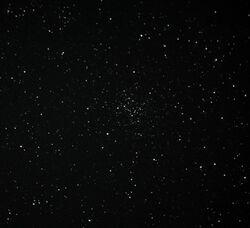Astronomy:NGC 2194
| NGC 2194 | |
|---|---|
 Amateur astrophotography of NGC 2194 | |
| Observation data (J2000 epoch) | |
| Constellation | Orion |
| Right ascension | 06h 13m 46s[1] |
| Declination | +12° 49′ 05″[1] |
| Distance | 12,320 ly (3,781 pc[2]) |
| Apparent magnitude (V) | 8.5 [1] |
| Apparent dimensions (V) | 9' |
| Physical characteristics | |
| Estimated age | 330 million years[2] |
| Other designations | Cr 87, Mel 43 |
NGC 2194 is an open cluster in the constellation Orion. The cluster is located about 10,000 light years away from Earth. It is rich and moderately concentrated. The cluster lies 33 arcminutes west-northwest of 73 Orionis.[3]
Observation history
It was discovered by William Herschel on 11 February 1784, and it was added in his catalogue as IV 5. It was added to the General Catalogue as 1383. The cluster was also observed by Adolph Cornelius Petersen in 1849 with the 18 cm refractor at the Altona Observatory. The cluster was also observed by Hermann Carl Vogel, without mentioning its General Catalogue number. John Louis Emil Dreyer added it to GCS as number 5380, as Heinrich Louis d'Arrest's discovery from 18 September 1862, without noticing it was already included.[4]
Characteristics
NGC 2194 is a rich and moderately concentrated, with Trumpler class III1r, open cluster. The brightest stars of the cluster are of magnitude 10, the brightest being of magnitude 10.26. The cluster has 149 members down to 15th magnitude. The main sequence turn off is at magnitude 14.5 and there are few red giants members.[5] There are some stars that are bluer than the turn-off point and if they are members of the cluster they are possibly blue stragglers.[6] The photometric study of the cluster by Sanner and al. concluded that the age of the cluster is 550 Myr and its distance is 2,900 pc.[5] Piatti et al. determined the age of the cluster to be 400 Myr and its distance to be 3,200 pc. The cluster has low metallicity (−0.27 ± 0.06). It is located 130 pc south of the galactic plane.[6]
References
- ↑ 1.0 1.1 1.2 "NGC 2194". SIMBAD. Centre de données astronomiques de Strasbourg. http://simbad.u-strasbg.fr/simbad/sim-basic?Ident=NGC+2194.
- ↑ 2.0 2.1 WEBDA: NGC 2194
- ↑ Thompson, Robert; Thompson, Barbara (2007) (in en). Illustrated Guide to Astronomical Wonders: From Novice to Master Observer. "O'Reilly Media, Inc.". p. 350. ISBN 9780596526856. https://books.google.com/books?id=ymt9nj_uPhwC&pg=PA350.
- ↑ Steinicke, Wolfgang (2010) (in en). Observing and Cataloguing Nebulae and Star Clusters: From Herschel to Dreyer's New General Catalogue. Cambridge University Press. p. 279. ISBN 9781139490108. https://books.google.com/books?id=wyWjVWYWoO8C&pg=PA279.
- ↑ 5.0 5.1 Sanner, Joerg; Altmann, Martin; Brunzendorf, Jens; Geffert, Michael (May 2000). "Photometric and kinematic studies of open star clusters. II. NGC 1960 (M 36) and NGC 2194". Astronomy and Astrophysics 357: 471–483. Bibcode: 2000A&A...357..471S.
- ↑ 6.0 6.1 Piatti, A. E.; Claria, J. J.; Ahumada, A. V. (21 April 2003). "The relatively young and metal-poor Galactic open cluster NGC 2194". Monthly Notices of the Royal Astronomical Society 340 (4): 1249–1260. doi:10.1046/j.1365-8711.2003.06365.x. Bibcode: 2003MNRAS.340.1249P.
External links
- NGC 2194 on WikiSky: DSS2, SDSS, GALEX, IRAS, Hydrogen α, X-Ray, Astrophoto, Sky Map, Articles and images
 |


